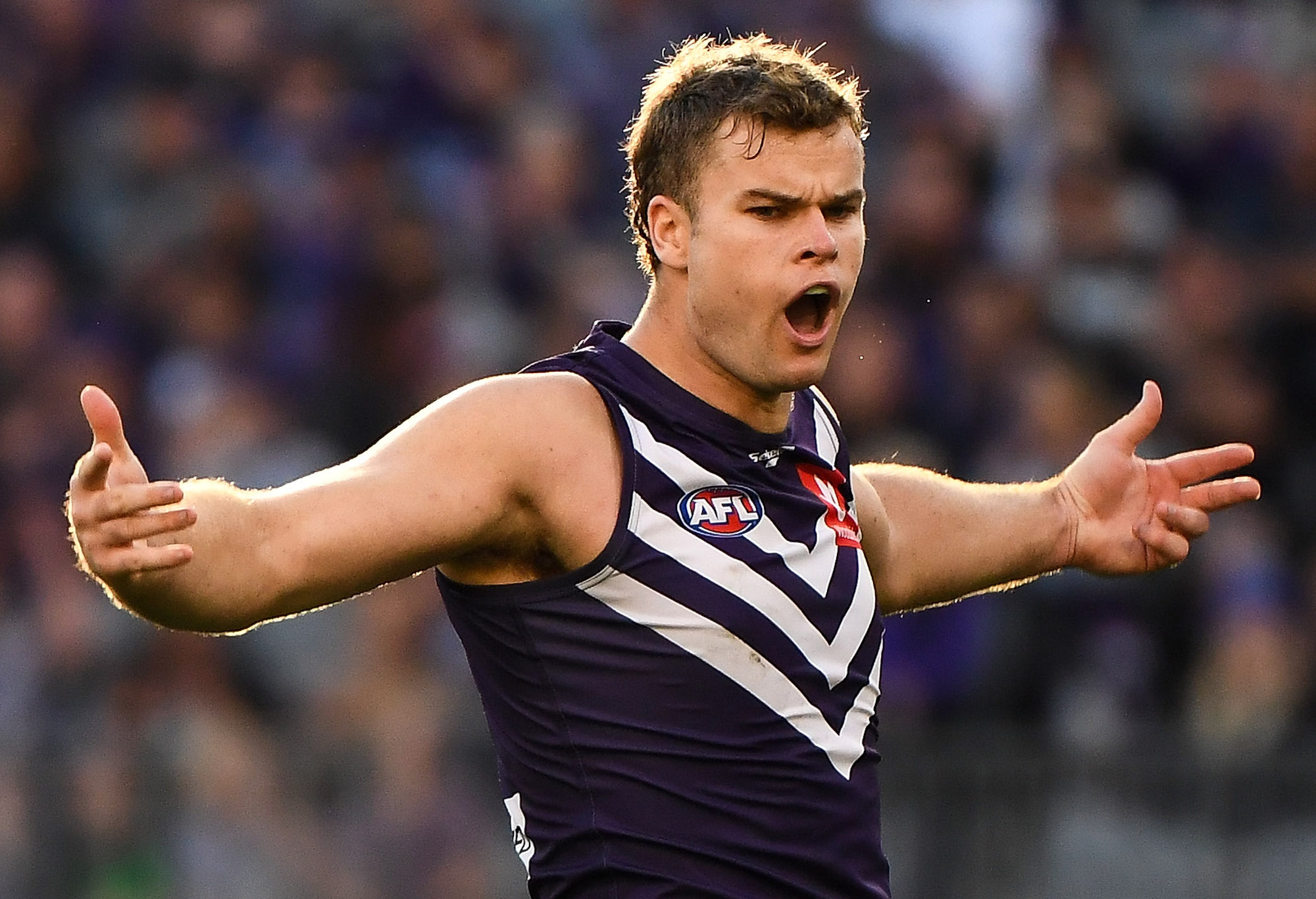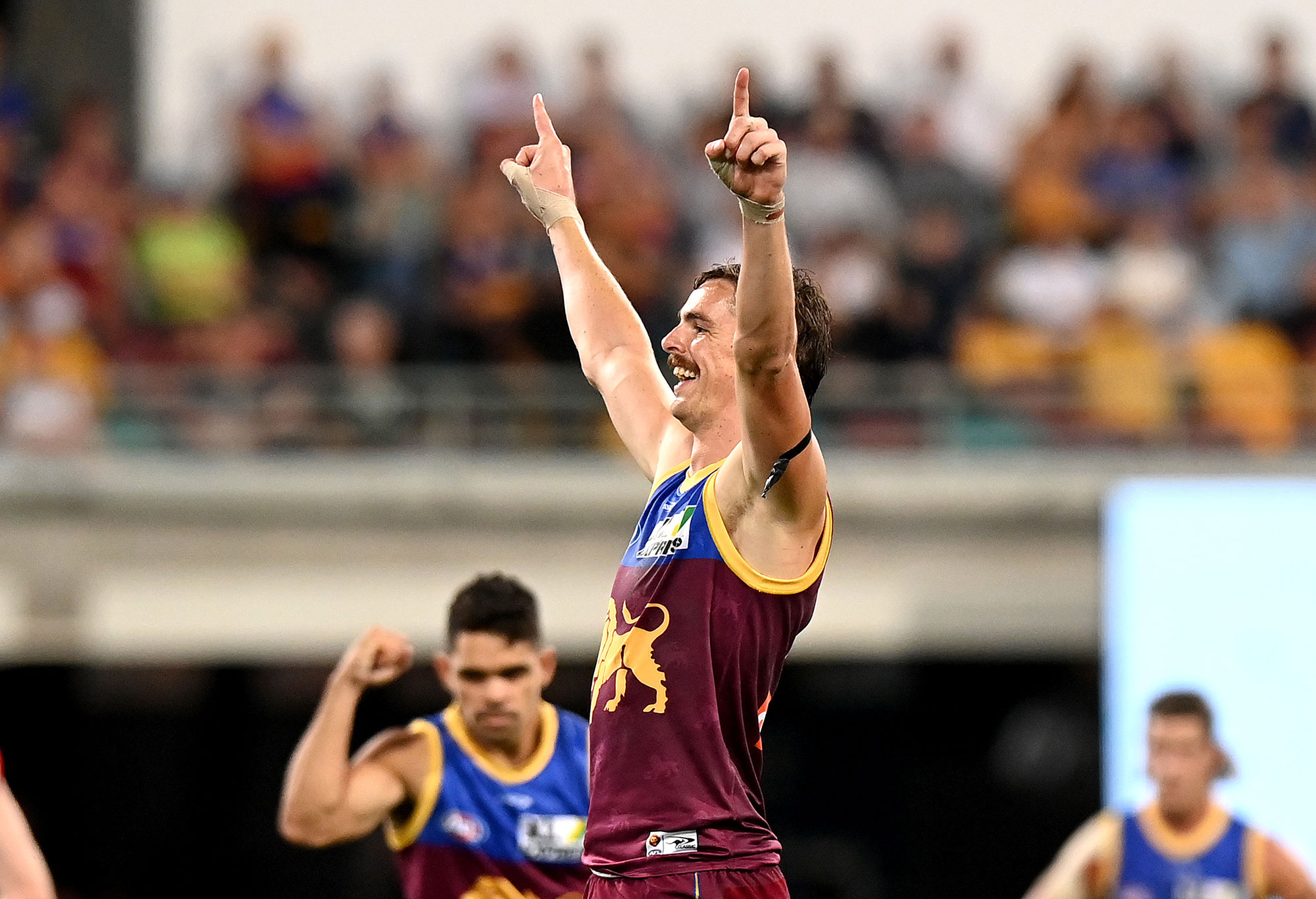Last week, dual West Coast premiership player Peter Sumich wrote an article in the West Australian suggesting Fremantle ruckman Sean Darcy was interested in a move to Geelong.
Sumich, who not-so-seamlessly morphs between outspoken analyst and wannabe-newsbreaker in Perth, also reported that Luke Ryan had his sights set on St Kilda.
Both players are managed by Phoenix Management Group’s Scott Lucas, who was blindsided by the story when it appeared, along with a photoshopped image of Darcy in a Cats jumper, on the back page of the paper. As Lucas read the story, he may have even asked himself ‘how so, Suma?‘
There was one other notable element in the story: Darcy is contracted until the end of 2024, and barely five months ago Ryan penned a deal with the Dockers until the end of 2027.
According to Justin Longmuir, the fact two of his players were contracted should be enough evidence to disregard the report as codswallop.
The story may have been wrong, but it was not incorrect on the basis of Darcy and Ryan’s contract statuses. Indeed, if the AFL has its way, Longmuir would not even waste his breath with the same answer in future years.
This is because the league has a vision to shift the player movement landscape towards an Americanised model where players could be traded against their will, thus becoming pawns to be shuffled at the whim of their clubs.
Instead of contracts tying players to teams, cities and fanbases, this US-mimicking world would only guarantee players remain in the AFL system for the duration of their deals and receive the money stipulated in the initial arrangement.
The AFL wants you to think of it as an extension of the National Draft. Nobody gets a choice where they are sent as 18-year olds, and if the league somehow gets their objective approved, nobody will have the benefit of choosing where they get traded to either.
A free market is utopia for the AFL.
This radical idea (in Australia) was communicated again to all 18 AFL club footy bosses last Tuesday. Whether it is a sneaky negotiation tactic amid discussions over the next Collective Bargaining Agreement, or a legitimate objective for the league, depends on who you trust.
Regardless, it is worth using this moment in time to evaluate what a player contract truly means in 2023 and whether it carries any weight at all.

(Photo by Daniel Carson/AFL Photos via Getty Images)
Back in 2016, Collingwood star Scott Pendlebury was asked about the state of player contracts in the AFL landscape.
His response – no doubt enlightened by his strong interest in US sports – foreshadowed negotiations between the league and players seven years down the road.
“Players can request trades to exactly the destination they want to go and clubs don’t get a fair return on what they sort of invested,” Pendlebury said in October 2016.
“I’ve heard Brad Scott [then North Melbourne coach] talk about how clubs should have the power, so it’s probably something that will happen in the near future.”
It’s taken a while to get there, but Pendlebury was right. The AFL wants clubs to have more power.
More specifically, it wants players to have less power.
It is unclear who said it first, but the phrase ‘contracts aren’t even worth the paper they are written on’ has been a phrase bandied about every trade period for some time.
Is it true? Literally, of course not. Paper is worth half a cent, and contracts can be worth millions of dollars.
But symbolically, it has some merit. Or at least, holds more truth than it did at the end of 2007, when Chris Judd told West Coast he wanted to be traded to Carlton. Yes, he was out of contract. But the way Judd asked clubs to sell themselves to him was a window into the player-led future the AFL is now trying to mitigate.
Across the last five years, 138 players have been traded. Some, such as Rory Lobb and Will Setterfield, have moved on twice in this timeframe. Incidentally, Lobb was under contract both times he asked to move; first from GWS to Fremantle in 2018, then the Dockers to the Western Bulldogs in 2022.
This is not a snipe at Lobb – though he does represent a Generation Z extension of Judd-like player power. His first move from Sydney to Perth was due to family reasons, and his second move from Perth to Melbourne was, you guessed it, also due to family reasons. Good on him for getting it done.
With the help of influential manager in Colin Young, Lobb’s long-term contracts at GWS and then Fremantle were more precisely just a deal to keep him in the system. It may not have been planned that way, but that’s how it played out. He didn’t want to be at the Dockers in 2022, but aside from that, he’s played where he wanted to play across three states and three clubs for his entire career, regardless of contract status.

Rory Lobb of the Bulldogs wrestles with Fremantle players. (Photo by Paul Kane/Getty Images)
Of the 138 traded players since October 2018, 64 have been traded while under contract. That’s 46 percent of all players who move during the transfer period, despite their pre-existing deals.
Of these 64, 32 have driven the trade themselves. Jordan Clark, Josh Dunkley, Dylan Shiel, Bradley Hill, Jack Higgins, Dayne Beams, Brayden Preuss (twice), Tom Hickey (twice), Lachie Neale and Mitch McGovern are just some examples which sit alongside Lobb as new-age products of an increasingly Americanised system.
So what about the other 32 players traded in contract? 20 of them have been pushed out by the club. That is 31 percent of contracted players who have left against their will.
Adam Treloar was the highest profile of these. He wanted to stay at Collingwood, but was made to feel as if he had no choice but to explore his options elsewhere.
As one player manager told The Roar, “Of course players can stay even if clubs tell them to go, but clubs are smart. They tell players there will be limited opportunities and likely no deal beyond their current contract.”
Gary Rohan was an example of this. Sydney wanted him to go to relieve salary cap stress and he begrudgingly accepted – provided they got him to Geelong, which they did.
Brodie Grundy was another victim of a list squeeze, as was Josh Bruce at St Kilda, Jesse Hogan at Melbourne, and Alex Witherden (who had two years remaining but was told opportunities would be limited) at Brisbane.
Ryan Burton was blindsided by Hawthorn’s desire to trade him to Port Adelaide in return for Chad Wingard, Blake Acres was steak knives in the deal that allowed Hill to get to St Kilda, while Dan Hannebery was nudged out the door at the Swans.
Ultimately they all agreed to go, and most players move on by the time pre-season training begins, but in these cases it was the club’s call first.
CLICK HERE for a seven-day free trial to watch the AFL on Kayo Sports.
In addition to the 32 players who wanted to leave and the 20 who were nudged out, there were 12 players from 2018-2022 who departed on mutually beneficial terms. Will Brodie, Eddie Betts, Sam Weideman and Peter Wright were just some of these.
So what does this all tell us? Contracts mean less than they ever have. That’s obvious. But they don’t mean nothing… at least not yet.
There have also been players that tried to get out, but couldn’t find an exit route that suited their employer. Matt Crouch in Adelaide, Tom Papley in Sydney and Joe Daniher at Essendon (when he tried to get to Sydney) are key examples of contracts working in favour of clubs.
Carlton got one more year out of Bryce Gibbs before allowing him to go at the end of 2017, and Gold Coast rejected Gary Ablett’s initial request for a trade in late 2016 before facilitating it 12 months later.
In the Swans’ case, the player contract worked for them – Papley stayed – but simultaneously against them – as Daniher did not have enough leverage to force his way out of the Bombers. Another year passed and his preference changed to the Lions, where he arrived as a free agent.

Joe Daniher (Photo by Bradley Kanaris/Getty Images)
Back to Lobb. Fremantle digging its heels in saying ‘he’s contracted’ at the end of 2021, while simultaneously believing they had lured Lachie Neale away from Brisbane (where he was contracted) was the height of hypocrisy.
This hypocrisy, however, is reflected across all clubs, players and their managers. It should not be a dirty word. It’s evident every single trade period. Self-interest takes precedence, and so it should.
For traditionalists, rest assured: the AFL player movement system is not fully Americanised yet, and won’t be for some time.
But if almost one in every two traded players are contracted – as has been the case over the last five years – we are probably closer to the AFL’s perfect model than most would care to admit.































































































